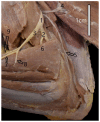The Structure of the Brachial Plexus in Selected Representatives of the Caniformia Suborder
- PMID: 35268135
- PMCID: PMC8908818
- DOI: 10.3390/ani12050566
The Structure of the Brachial Plexus in Selected Representatives of the Caniformia Suborder
Abstract
Like most structures, the brachial plexus is subject to species variation. Analysing this structure over a wide spectrum of species, we can obtain a complex view of the changes-in a given group of animals. The aim of this study was to describe the brachial plexus anatomy of species from two families of Caniformia. We analysed the brachial plexus structure of five species from two families of Caniformia: Canidae and Mustelidae. The cadavers were obtained from breeders and hunters. All were fixed by being kept in a 10% formaldehyde solution for two weeks. This study allows us to present the similarities as well as the differences between species and families. Our study reveals different trends in the course of the individual nerves and innervations of the thoracic limb. A species-specific feature is the extent of the brachial plexus, as each species has a specific number of ventral branches of the spinal nerves in the brachial plexus. However, a characteristic of the family Mustelidae is the course of the median nerve through the epicondylar foramen. Within the Canidae, two species are characterised by a very long branch for the coracobrachialis muscle. The general conclusion is that the brachial plexus of species belonging to the Caniformia is subject to variation within families and species, as well as individual variation while maintaining a general schematic for the group.
Keywords: American mink; European pine marten; common raccoon dog; comparative anatomy; neuroanatomy; red fox.
Conflict of interest statement
The authors declare no conflict of interest.
Figures





Similar articles
-
Origin and Distribution of the Brachial Plexus in Two Procyonids (Procyon cancrivorus and Nasua nasua, Carnivora).Animals (Basel). 2023 Jan 6;13(2):210. doi: 10.3390/ani13020210. Animals (Basel). 2023. PMID: 36670750 Free PMC article.
-
The anatomical structure of the brachial plexus of the guinea pig (cavia porcellus).Folia Morphol (Warsz). 2024 Dec 15. doi: 10.5603/fm.101041. Online ahead of print. Folia Morphol (Warsz). 2024. PMID: 39674900
-
Origin and distribution of the brachial plexus of the Van cats.Anat Histol Embryol. 2020 Mar;49(2):251-259. doi: 10.1111/ahe.12523. Epub 2019 Dec 17. Anat Histol Embryol. 2020. PMID: 31845374
-
Neuroanatomy of the brachial plexus: normal and variant anatomy of its formation.Surg Radiol Anat. 2010 Mar;32(3):291-7. doi: 10.1007/s00276-010-0646-0. Epub 2010 Mar 17. Surg Radiol Anat. 2010. PMID: 20237781 Review.
-
Neuroanatomy of the brachial plexus: the missing link in the continuity between the central and peripheral nervous systems.Microsurgery. 2006;26(4):218-29. doi: 10.1002/micr.20233. Microsurgery. 2006. PMID: 16628658 Review.
Cited by
-
Comparison of two blind brachial plexus blocks in goat cadavers.J Adv Vet Anim Res. 2025 Mar 24;12(1):64-69. doi: 10.5455/javar.2025.l872. eCollection 2025 Mar. J Adv Vet Anim Res. 2025. PMID: 40568512 Free PMC article.
-
Comparative anatomy of the felid brachial plexus reflects differing hunting strategies between Pantherinae (snow leopard, Panthera uncia) and Felinae (domestic cat, Felis catus).PLoS One. 2023 Aug 9;18(8):e0289660. doi: 10.1371/journal.pone.0289660. eCollection 2023. PLoS One. 2023. PMID: 37556421 Free PMC article.
-
Origin and Distribution of the Brachial Plexus in Two Procyonids (Procyon cancrivorus and Nasua nasua, Carnivora).Animals (Basel). 2023 Jan 6;13(2):210. doi: 10.3390/ani13020210. Animals (Basel). 2023. PMID: 36670750 Free PMC article.
-
Five-headed triceps brachii muscle, with an unusual communication between the musculocutaneous and median nerves in a cross-breed dog cadaver: a case report.BMC Vet Res. 2025 Mar 3;21(1):130. doi: 10.1186/s12917-025-04610-5. BMC Vet Res. 2025. PMID: 40025498 Free PMC article.
-
Update on the anatomy of the brachial plexus in dogs: Body weight correlation and contralateral comparison in a cadaveric study.PLoS One. 2023 Feb 23;18(2):e0282179. doi: 10.1371/journal.pone.0282179. eCollection 2023. PLoS One. 2023. PMID: 36821631 Free PMC article.
References
-
- Burgin C.J., Wilson D.E., Mittermeier R.A., Rylands A.B., Lacher T.E., Sechrest W. Illustrated Checklist of the Mammals of the World. Lynx Edicions; Barcelona, Spain: 2020. p. 27.
-
- Wilson D.E., Reeder D.M. Mammal Species of the World. A Taxonomic and Geographic Reference. 3rd ed. Johns Hopkins University Press; Baltimore, MD, USA: 2005.
-
- Böhmer C., Fabre A.C., Taverne M., Herbin M., Peigne S., Herrel A. Functional relationship between myology and ecology in carnivores: Do forelimb muscles reflect adaptations to prehension? Biol. J. Linn. Soc. Lond. 2019;127:661–680. doi: 10.1093/biolinnean/blz036. - DOI
-
- Araujo H.N., Jr., Oliveira G.B., Costa H.S., Lopes P.M.A., Oliveira R.E.M., Bezerra F.V.F., Moura C.E.B., Oliveira M.F. Anatomy of the brachial plexus in the Mongolian gerbil (Meriones unguiculatus Milne-Edwards, 1867) Vet. Med. 2018;63:476–481. doi: 10.17221/78/2017-VETMED. - DOI
LinkOut - more resources
Full Text Sources

